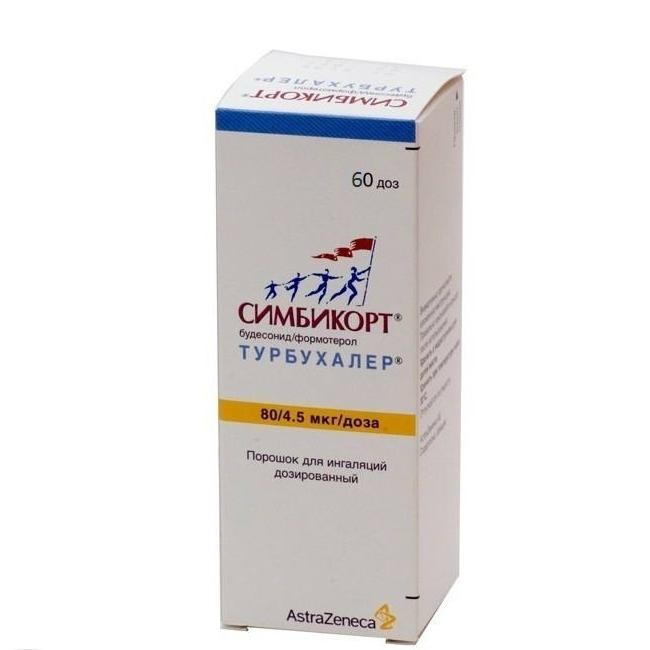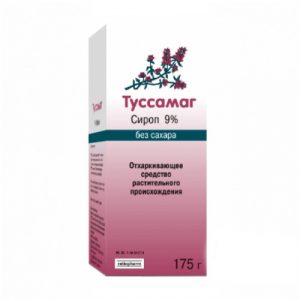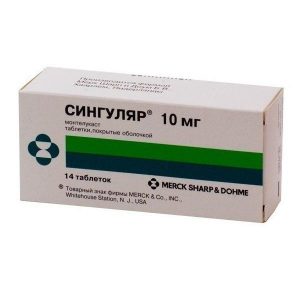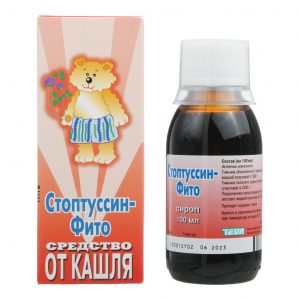Description
Latin name
Simbikort Turbuhaler
60
package.
Pharmacological action
Symbicort Turbuhaler – a combined drug for the treatment of bronchial asthma. Contains formoterol and budesonide, which have different mechanisms of action and exhibit an additive effect with respect to reducing the frequency of exacerbations of bronchial asthma.
Budesonide – GCS, after inhalation, has an anti-inflammatory effect on the respiratory tract, which lasts several hours and is dose-dependent.
Reduces the severity of symptoms and the frequency of exacerbations of bronchial asthma. With the appointment of budesonide in the form of inhalation, a lower incidence of serious undesirable effects is noted than with systemic corticosteroids. Reduces the severity of edema of the bronchial mucosa, mucus production, sputum formation and respiratory tract hyperresponsiveness. The exact mechanism of the anti-inflammatory action of GCS is not known.
Formoterol is a selective 2-adrenergic receptor agonist. Causes relaxation of the smooth muscles of the bronchi in patients with reversible airway obstruction. The bronchodilator effect is dose-dependent, occurs within 1-3 minutes after inhalation and persists for at least 12 hours after taking a single dose.
In clinical studies, it was found that with the combined use of formoterol and budesonide, the severity of symptoms of bronchial asthma decreases, lung function improves, and the frequency of exacerbations of the disease decreases.
The effect of Symbicort Turbuhaler on lung function is consistent with the combination of budesonide and formoterol monotherapy and is greater than the effect of budesonide alone. There was no decrease in anti-asthma action over time. The drug has good tolerance. The drug has good tolerance.
While taking Symbicort Turbuhaler as maintenance therapy for 12 weeks in children aged 6 to 11 years (two inhalations of 80 / 4.5 mcg / inhalation 2 times / day), lung function improved and drug tolerance was noted, compared with the appropriate dose of budesonide Turbuhaler.
In patients with severe chronic obstructive pulmonary disease (initial FEV1 – 36%) with the use of Symbicort Turbuhaler, there was a significant decrease in the frequency of exacerbations of the disease compared with patients who received only formoterol or placebo as the treatment (average exacerbation rate was 1.4 compared to 1.8- 1.9 in the placebo / formoterol group).
There was no difference between taking Symbicort and formoterol in terms of FEV1.
Indications
Bronchial asthma (not adequately controlled by the use of short-acting inhaled corticosteroids and beta2-adrenergic agonists as demanding therapy, or adequately controlled by inhaled corticosteroids and long-acting 2-adrenergic agonists) – as maintenance therapy and for relieving seizures.
Symptomatic therapy in patients with severe chronic obstructive pulmonary disease (FEV
Contraindications
Children under 6 years.
Hypersensitivity to budesonide, formoterol, or inhaled lactose.
Ingredients
budeneside, srdlkrpd lactose monohydrate.
Dosage and administration of
should be taken into account not only when starting treatment with combined drugs, but also when changing the dose of the drug.
In the event that individual patients require a different combination of doses of active substances than in Symbicort Turbuhaler, beta2-adrenergic agonists and / or GCS should be prescribed separately in separate inhalers.
Dose should be reduced to the smallest, against the background of which optimal control of symptoms of bronchial asthma is maintained. Patients should be under the constant supervision of a doctor to adequately select the dose of Symbicort Turbuhaler. When achieving full control over the symptoms of bronchial asthma against the background of the minimum recommended dose of the drug, at the next stage, you can try the appointment of monotherapy with inhaled corticosteroids.
There are two approaches to prescribing therapy with Symbicort Turbuhaler.
A.
Symbicort Turbuhaler as maintenance therapy: the drug is prescribed as maintenance therapy in combination with a separate short-acting beta2-adrenostimulator to relieve seizures.
The patient must always have a separate inhaler with a short-acting beta2-adrenostimulator to stop attacks.
Adults (18 years of age and older) are prescribed Symbicort Turbuhaler 80 / 4.5 mcg / dose and 160 / 4.5 mcg / dose, 1-2 inhalations 2 times / day. If necessary, it is possible to increase the dose to 4 inhalations 2 times / day.
Adolescents (12-17 years old) are prescribed Symbicort Turbuhaler 80 / 4.5 mcg / dose and 160 / 4.5 mcg / dose, 1-2 inhalations 2 times / day.
Children over 6 years of age are prescribed Symbicort Turbuhaler 80 / 4.5 mcg / dose, 1-2 inhalations 2 times / day.
After optimal control of symptoms of bronchial asthma is achieved while taking the drug 2 times / day, it is recommended to titrate the dose to the least effective, up to 1 time / day, in cases where, according to the doctor, the patient needs maintenance therapy in combination with long-acting bronchodilators.
An increase in the incidence of short-acting beta2-adrenostimulants is an indication of worsening overall disease control and requires a review of anti-asthma therapy.
Storage conditions
At a temperature not exceeding 30 ° C.
Shelf life
2 years
Active ingredient
budesonide, formoterol
Dosage form
powder for inhalation
Appointment by
Adult by appointment, Nursing doctor
Indications
Low learning ability, Bronchial asthma, Bronchospasm
AstraZeneca, Britain




